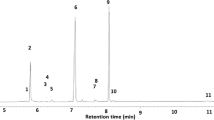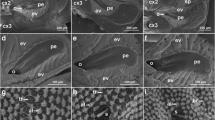Abstract
Aeration and exocrine gland extracts were analyzed for three Coreidae and two Alydidae. Males of all the species studied emit volatile blends that are probably pheromones, but sexual communication in these insects evolved differently. In the alydids,Riptortus serripes andMirperus scutellaris, the metathoracic scent glands are sexually dimorphic, and the dimorphisms are expressed chemically. Secretions from the male alydids contain high concentrations of esters or alcohols [e.g., (E)-2-hexenyl (Z)-3-hexenoate, (E)-2-hexenyl butyrate, and (E)-2-octenol], while females produce mainly acids and aldehydes [e.g., butyric and hexanoic acids, and (E)-2-hexenal]. In the coreids,Amblypelta lutescens lutescens, Amblypelta nitida, andLeptoglossus phyllopus, the metathoracic scent glands are not sexually dimorphic, but male- and species-specific volatiles are released, apparently from cells in the cuticular epidermis. The coreid male-specific volatiles are primarily monoterpenes and sesquiterpenes, including (−)-(3R)-(E)-nerolidol as the major component fromA. lutescens lutescens (an Australasian species) andL. phyllopus (a Nearctic species). Only (+)-(3S)-(E)-nerolidol is commonly found in plants so (E)-nerolidol from these coreids is environmentally unique because of its chirality.
Similar content being viewed by others
References
Aldrich, J.R. 1988a. Chemical ecology of the Heteroptera.Annu. Rev. Entomol. 33:211–238.
Aldrich, J.R. 1988b. Chemistry and biological activity of pentatomoid sex pheromones, pp. 417–431,in H.G. Cutler (ed.). Biologically Active Natural Products: Potential Use in Agriculture. ACS Symposium Series. 380, Washington, D.C.
Aldrich, J.R., Blum, M.S., andDuffey, S.S. 1976. Male specific natural products in the bug,Leptoglossus phyllopus: Chemistry and possible function.J. Insect Physiol. 22:1201–1206.
Aldrich, J.R., Blum, M.S., andFales, H.M. 1979. Species specific male scents of leaf-footed bugs,Leptoglossus spp. (Heteroptera: Coeridae).J. Chem. Ecol. 5:53–62.
Aldrich, J.R., Oliver, J.E., Lusby, W.R., andKochansky, J.P. 1986. Identification of male specific exocrine secretions from predatory stink bugs (Hemiptera, Pentatomidae).Arch. Insect Biochem. Physiol. 3:1–12.
Aldrich, J.R., Lusby, W.R., Marron, B.E., Nicolaou, K.C., Hoffman, M.P., andWilson, L.T. 1989. Pheromone blends of green stink bugs and possible parasitoid selection.Naturwissenschaften 76:173–176.
Aldrich, J.R., Hoffmann, M.P., Kochansky, J.P., Lusby, W.R., Eger, J.E., andPayne, J.A. 1991a. Identification and attractiveness of a major pheromone component for NearcticEuschistus spp. stink bugs (Heteroptera: Pentatomidae).Environ. Entomol. 20:478–483.
Aldrich, J.R., Kochansky, J.P., Lusby, W.R., andBorges, M. 1991b. Pheromone blends of predaceous bugs (Heteroptera: Pentatomidae:Podisus spp.).Z. Naturforsch. 46C:264–269.
Aldrich, J.R., Numata, H., Borges, M., Bin, F., Waite, G.K., andLusby, W.R. 1993. Artifacts and pheromone blends fromNezara spp. and other stink bugs (Heteroptera: Pentatomidae).Z. Naturforsch. 48C:73–79.
Anet, E.F.L.J. 1970. Synthesis of (E,Z)-α-, (Z,Z)-α-, and (Z)-β-farnesene.Aust. J. Chem. 23:2101–2108.
Baker, J.T., Blake, J.D., MacLeod, J.K., Ironside, D.A., andJohnson, I.C. 1972. The volatile constituents of the scent gland reservoir of the fruit-spotting bug,Amblypelta nitida.Aust. J. Chem. 25:393–400.
Bigger, M. 1985. The effect of attack byAmblypelta cocophaga China (Hemiptera: coreidae) on growth ofEucalyptus deglupta in the Solomon Islands.Bull. Entomol. Res. 75:595–608.
Brown, E.S. 1958. Injury to cacao byAmblypelta Stal (Hemiptera, Coreidae) with a summary of food-plants of species of this genus.Bull. Entomol. Res. 49:543–554.
Burger, B.V., Munro, Z., Roth, M., Spies, H.S.C., Truter, V., Tribe, G.D., andCrewe, R.M. 1983. Composition of the heterogeneous sex attracting secretion of the dung beetle,Kheper larmarcki.Z. Naturforsch. 38C:848–855.
Cane, D.E., Ha, H.-J., McIlwaine, D.B., andPascoe, K.O. 1990. The synthesis of (3R)-nerolidol.Tetrahedron Lett. 31:7553–7554.
Carayon, J. 1981. Dimorphisme sexuel des glandes tegumentaires et production de phéromones chez les Hémipteres Pentatomoidea.C.R. Acad. Sci. Ser. III 292:867–870.
Carver, M., Gross, G.F., andWoodward, T.E. 1991. Hemiptera (bugs, leafhoppers, cicadas, aphids, scale insects, etc.), pp. 429–509,in I.D. Naumann (ed.). The Insects of Australia. Melbourne University Press, Victoria.
Clausen, C.P. 1978. Introduced Parasites and Predators of Arthropod Pests and Weeds: A World Review. USDA Handbook No. 480. Washington, D.C. 545 pp.
Donaldson, J.F. 1983. The Australian species ofAmblypelta Stal (Hemiptera: Coreidae).J. Aust. Entomol. Soc. 22:47–52.
Ellis, H.C., Dutcher, J.D., andPickering, J. 1992. Pecan insets,in R.M. McPherson and G.K. Douce (eds.). Summary of Losses from Insect Damage and Costs of Control in Georgia, 1991. Special Publication No. 81. Georgia Agriculture Experiment Station, College of Agriculture and Environmental Science, University of Georgia, Athens.
Games, D.E., andStaddon, B.W. 1973. Chemical expression of a sexual dimorphism in the tubular scent glands of the milkweed bug,Oncopeltus fasciatus (Dallas) (Heteroptera; Lygaeidae).Experientia 29:532–533.
Horton, D., Dutcher, J.D., Ellis, U.C., Payne, J.A., andYonce, C.E. 1992. Peach insects,in R.M. McPherson and G.K. Douce (eds.). Summary of Losses from Insect Damage and Costs of Control in Georgia, 1991. Special Publication No. 81. Georgia Agriculture Experiment Station, College of Agriculture and Environmental Science, University of Georgia, Athens.
Jackson, B.D., Morgan, andBillen, J.P.J. 1990. A note on pygidial glands of primitive Australian ants: A new source of odorous chemicals,in A.R. McCaffery and I.D. Wilson (eds.). Chromatography and Isolation of Insect Hormones and Pheromones. Plenum Press, New York.
Jones, T.G.H., andHarvey, J.M. 1936. Essential oils from the Queensland flora-Part VIII. The identity of melaleucol with nerolidol.Proc. R. Soc. Queensl. 47:92–93.
Kochansky, J.P., Aldrich, J.R., andLusby, W.R. 1989. Synthesis and pheromonal activity of 6,10,13-trimethyl-1-tetradecanol for predatory stink bug,Stiretrus anchorago (Heteroptera: Pentatomidae).J. Chem. Ecol. 15:1717–1728.
Leal, W.S., andKadosawa, T. 1992. (E)-2-Hexenyl hexanoate, the alarm pheromone of the bean bugRiptortus clavatus (Heteroptera: Alydidae).Biosci. Biotech. Biochem. 56:1004–1005.
Leal, W.S.,Kadosawa, T., andNakamori, H. 1993a. Aggregation pheromone of the bean bug,Riptortus clavatus. Proceedings, 37th Annual Meeting of the Japanese Society of Bioscience, Biotechnology and Agrochemistry. p. 212.
Leal, W.S.,Nakamori, H., andKadosawa, T. 1993b. Ecological significance ofRiptortus clavatus aggregation pheromone to adults and nymphs. Proceedings, 37th Annual Meeting of the Society of Applied Entomology and Zoology, p. 9.
Miles, P.W. 1987. Plant-sucking bugs can remove the contents of cells without mechanical damage.Experientia 43:937–939.
Murray, K.E. 1969.α-Farnesene: Isolation from the natural coating of apples.Aust. J. Chem. 22:197–204.
Numata, H., Kon, M., andHidaka, T. 1990. Male adults attract conspecific adults in the bean bug,Riptortus clavatus Thunberg (Heteroptera: Alydidae).Appl. Entomol. Zool. 25:144–145.
Oliver, J.E., Aldrich, J.R., Lusby, W.R., Waters, R.M., andJames, D.G. 1992. A male produced pheromone of the spined citrus bug.Tetrahedron Lett. 33:891–894.
Picker, K., Ritchie, E., Taylor, W.C. 1976. The chemical constituents of AustralianFlindersia species. XXI. An examination of the bark and the leaves ofF. laevicarpa.Aust. J. Chem. 29:2023–2036.
Rucker, G., Langmann, B., andDe Siqueira, N.S. 1981. Inhaltsstoffe vonAristolochia triangularis.Planta Med. 41:143–149.
Schuh, R.T. 1986. The influence of cladistics on heteropteran classification.Annu. Rev. Entomol. 31:67–93.
Smith, R.F., Pierce, H.D., Jr., andBorden, J.H. 1991. Sex pheromone of the mullein bug,Campylomma verbasci (Meyer) (Heteroptera: Miridae).J. Chem. Ecol. 17:1437–1447.
Sutherland, M.D., Webb, L.J., andWells, J.W. 1960. Terpenoid chemistry. III. The essential oils ofEucalyptus deglupta Blume andE. torelliana.Aust. J. Chem. 13:357–366.
Waite, G.K. 1990.Amblypelta spp. (Hemiptera: Coreidae) and green fruit drop in lychees.Trop. Pest Management 36:353–355.
Ward, J.P., andVanDorp, D.A. 1969. A stereospecific synthesis of 4-oxo-2-trans-hexenal.Recueil 88:989–993.
Yasuda, K. 1990. Ecology of the leaf footed bug,Leptoglossus australis Fabricius (Heteroptera: Coreidae), in the sub-tropical region of Japan.Trop. Agricult. Res. Ser. No. 23:229–238.
Author information
Authors and Affiliations
Rights and permissions
About this article
Cite this article
Aldrich, J.R., Waite, G.K., Moore, C. et al. Male-specific volatiles from nearctic and Australasian true bugs (Heteroptera: Coreidae and Alydidae). J Chem Ecol 19, 2767–2781 (1993). https://doi.org/10.1007/BF00980582
Received:
Accepted:
Issue Date:
DOI: https://doi.org/10.1007/BF00980582




